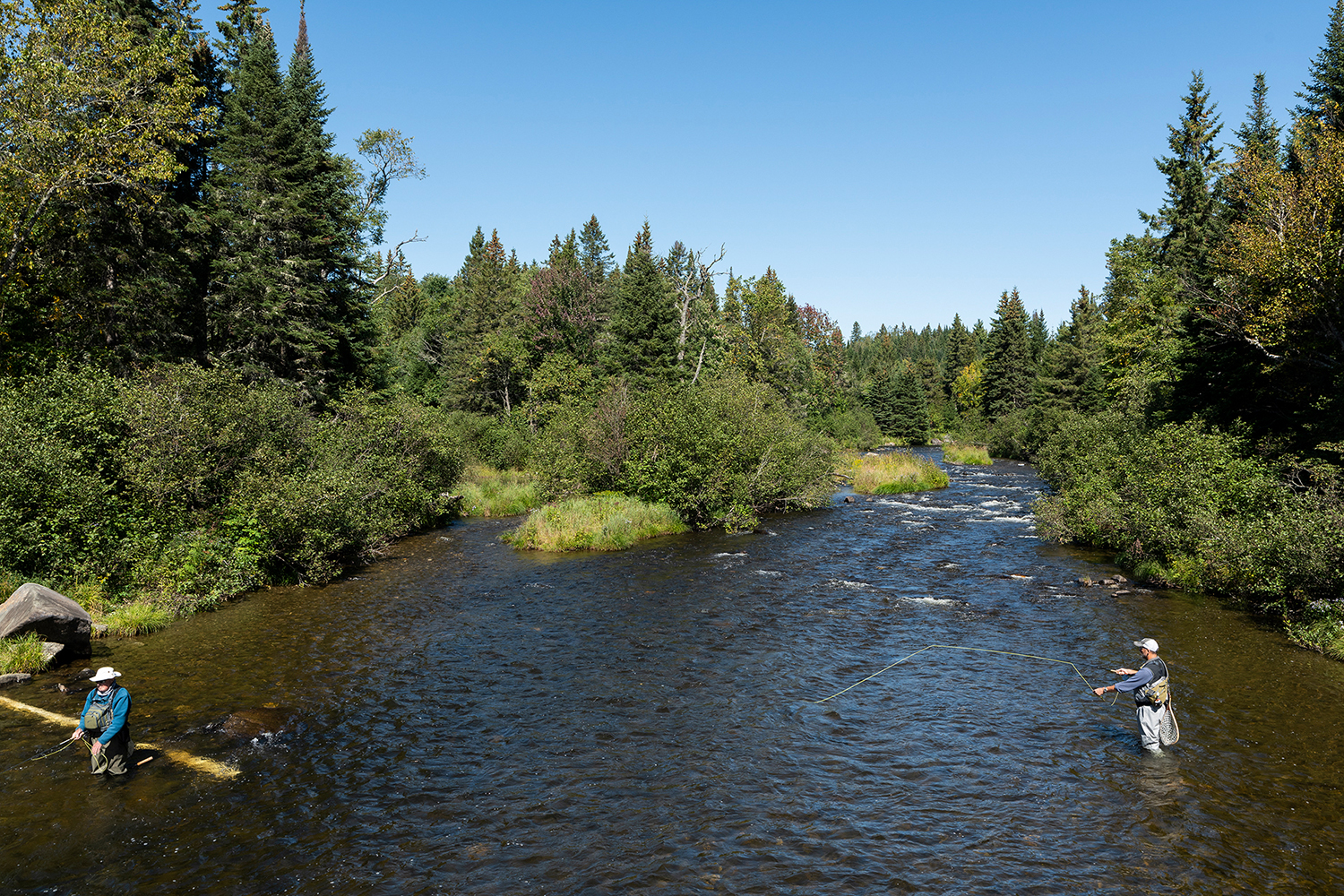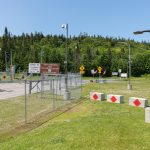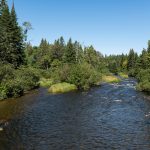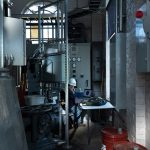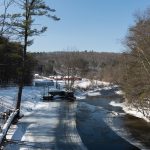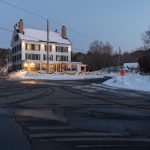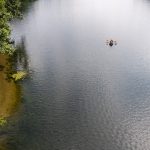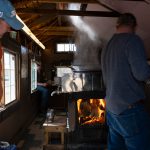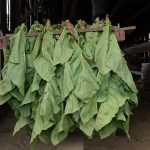Landscape photographer Janet L. Pritchard, a professor of photography in the Department of Art and Art History, received a 2019 Guggenheim Fellowship to support her current project, “More than a River: the Connecticut River Watershed,” which involves photographing the Connecticut River landscape as a complex set of interconnected systems where the present bumps up against the past in telling ways.
Guggenheim Fellowships are awarded by the John Simon Guggenheim Memorial Foundation to artists who have demonstrated exceptional capacity for significant exhibition or performance of their work or who have productive scholarship or exceptional creative ability and a significant record of publication as writers, scholars, and scientists.
Pritchard’s photography is part of prestigious permanent collections in venues including the American Antiquarian Society, George Eastman House, National Trust for Historic Preservation, Philadelphia Museum of Art, Polaroid Corp., Rhode Island School of Design Museum of Art, Roman Vindolanda Museum in Northumberland, U.K., and Yellowstone National Park Museum. Her new book “Yellowstone, an American Love Story” will be published early next year by George F. Thompson Publishing in association with the American Land Publishing Project.
Pritchard began taking photographs as a youngster and helped to start a camera club in her school. She grew up in central New Jersey spending most of her time in the outdoors walking through woods and playing sports. She left college for a while to work for an outdoor education program before heading back to her studies with the intent of becoming a photographer and a college professor. She arrived at UConn in 2001. She spoke with UConn Today about her approach to photography and her work on the Connecticut River project.
How do you make a decision on what you’re going to be focusing on for such a concentrated period of time?
Underneath, sort of the bones of the way I think about making photographs and putting them together as projects is they’re all based in history of landscapes, places, interactions between people and physical terrain. It’s why when I introduce myself and say that I’m a landscape photographer I borrow a very simple, direct definition from [writer] Barry Lopez, which is that landscape photography is the intersection of nature and culture. When I look at the land, I’m interested how it was formed physically, geologically, how it’s been used over time by different groups of people, the economics of it, resource issues of it, the personal issues of lives lived there. The emphasis on those different things changes a little bit in each of the projects, but it’s always there. For example, “Dwelling Expressions of Time,” which chronologically is the first project that’s on my website, starts early on from when I got here to start teaching at UConn in 2001. One of the things that I noticed is that when I was walking through the woods, I expected to find a landscape that was very much like the woods of my childhood in New Jersey. What I found when I started walking through the woods was a lot more evidence of, in particular 19th century and maybe even back to the mid-18th century, usage by people. For example, one really obvious thing is small dams creating spaces for water, harvesting, water power. Those kinds of things really caught my attention. That’s what I was trying to photograph — this experience of mine, of walking through the woods and having a collision of time, the past and the present, both being present. There is a Faulkner quote about the past, not even really being past.
You took a photo at the exact same spot where Frank Jay Haynes, one of the early official photographers of Yellowstone, took a photo. You’ve got a postcard of that scene on the dashboard of a car, which is a really different way to look at the same scene that was taken so many years ago, but obviously in a different context.
There was a group that was connected throughout the Western U.S. that was working on a project started by Mark Klett and Rick Dingus called the Re-photographic Survey Project that was published in a book called “Second View.” Later there was another book called “Third Views Second Sights: A Rephotographic Survey of the American West.” Re-photography is a technique that’s used in geology in particular most commonly for erosion studies and civic planning. They’ll go back and look at historic photographs, take photographs now from the same location and they’ll see the changes in the land. It’s a quite precise technique. I grew up, sort of speaking academically, as a photographer around that work and was very influenced and interested in it. I never wanted to do it myself. My interest is in making work more personal, emotional, less scientific, but yet it still interests me a great deal. That’s really where that came from.
It also was that specific picture rather than the technique that came from my experience of the Yellowstone project. I bought a vintage picture postcard that really intrigued me. It was on the back of a picture of Golden Gate Canyon. I had purchased a number of pictures of Golden Gate Canyon wondering why almost a hundred years later there were so many photographs of this place in the park that I didn’t know about. I’d spent a great deal of time in the greater Yellowstone ecosystem, but not actually in the park, but I knew the greatest hits of the park, and this wasn’t one of them. And yet here we were a hundred years later, and there were many postcards of this same view. So, in 2005 thinking about future work after the Dwelling project, knowing I had a sabbatical coming up in a few years, I went out and I spent a week there. One of the first things I did was to go see the Canyon.
The Connecticut River project is a departure for you in a sense because you’ve been taking photos of landscapes for years, but a river project is not something that you’ve done previously on this scale.
Definitely not on this scale. My awareness of and interest in watersheds is longstanding. I have a very clear recollection of being a child and riding in the car with my father and we very much bonded over landscapes in various way; riding by a sign in some woods that identified it as part of a particular watershed was the first time. He told me what a watershed was and that was a conceptual shift for me to think about a landscape in that sense. So, I’ve been aware of watersheds and thinking about them for many years and I’ve photographed rivers in a small way. But this project is somewhat of a departure.
When I moved to Connecticut, I had a pretty clear sense of the Connecticut River as dividing the state economically, socially, historically. I did do a little bit of reading about that. [The New Yorker’s] John McPhee’s writing has influenced me a great deal over the years. I think of him as one of my heroes in many ways; he’s always fascinated me. Right about that same time his book “The Founding Fish” (2003) came out, which is all about the shad, and he writes about the Delaware and the Connecticut. I had grown up around the Delaware so that connected to those two landscapes for me in some ways — the landscape of my childhood in the landscape of a different time in my life. So I was very interested in the river and it was in the back of my mind for a long time.
One of the things that I do when in these bigger projects is, I sort of lean on this quote that I found a number of years ago in an essay written by Michael Poland on the history of gardens [in his afterword titled “The Garden’s Prospects in America,” Keeping Eden: A History of Gardening in America, 1992]. I spent a long time with gardens, which comes out of my dissertation work from graduate school. [The quote] is from an 11th century Japanese garden manual titled Sakuteiki (“Records of Garden Keeping”) and is roughly: “Begin by considering the lay of the land and the water. Study the works of past masters and recall the places of beauty that you know. Then, on your chosen site, let memory speak and make into your own that which moves you most.” I really think of that as sort of three phases which I emulate in the structures of my bigger projects, which is to begin by considering the lay of the land and the water, going out and seeing it and talking to people, looking at things and, and reading a little bit. It’s about being there and it’s about experiencing it. And it’s about getting to know other people who experienced it. I’ll never be a local, but I don’t want to be a tourist. I need to be somewhere in between.
It’s been said that the Connecticut River is considered the heart of New England, the cradle of New England culture. On your website you’ve got pretty much a travelogue of New England — Frank, the welder in Vermont, the Barrett Fishway in Holyoke, Massachusetts, you’re under the Founder’s Bridge in Hartford. It’s a varied landscape, almost like a tour of the country visually as you come down from the North.
I think that character will stay with it. My intention is for this to go to a book. I feel really strongly that when you’re dealing with photography in the way that I do, it takes time for people to absorb it. It takes me years to make the work. I hope it at least takes minutes, maybe hours for people to absorb it. I think these layers of interest, layers of usage of the river, changing relationships to the river, all of these things can come out in a much deeper way than they can in an exhibition. I do exhibit, but I never have a chance to exhibit an entire project. They’re too big. The Yellowstone book is over 200 pages as it’s currently laid out. It’s 186 photographs. That’s a lot of writing involved to describe what’s there. It all takes time and I’m not fast [as a writer or photographer]. It all has to sort of soak in and my understanding of it has to become more sophisticated through experience and research.
Receiving a Guggenheim fellowship is one of the most significant honors that an artist can receive because it recognizes your work throughout the years. It says you are a productive scholar and have a significant record of achievement. Now that you’ve thought about it a bit, what’s your feeling about it?
Part of what’s great about them [the Guggenheim Foundation] is they have a clear idea for themselves of what they want to support. It’s great to have the resources but it’s also very satisfying to have the recognition. External validation is something that doesn’t happen often in the life of an artist in this country. What we do is not as tangible as what an engineer does or a chemist, and so it’s not as often that we get recognized as contributing to society in a larger way. I’d like to think of it as a recognition, at least from a peer group, that I’m doing a good job.
Listen to Janet Pritchard talk about her work on the latest episode of UConn 360 here:
